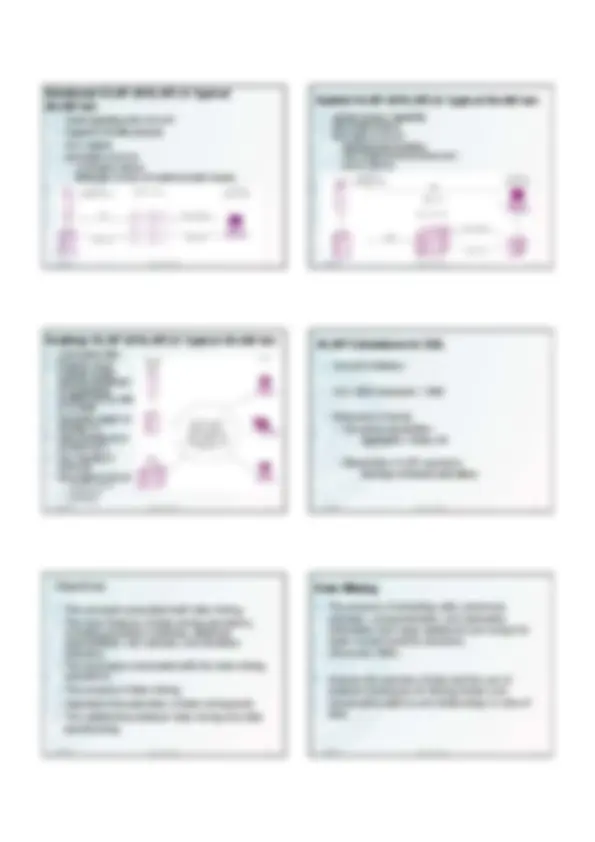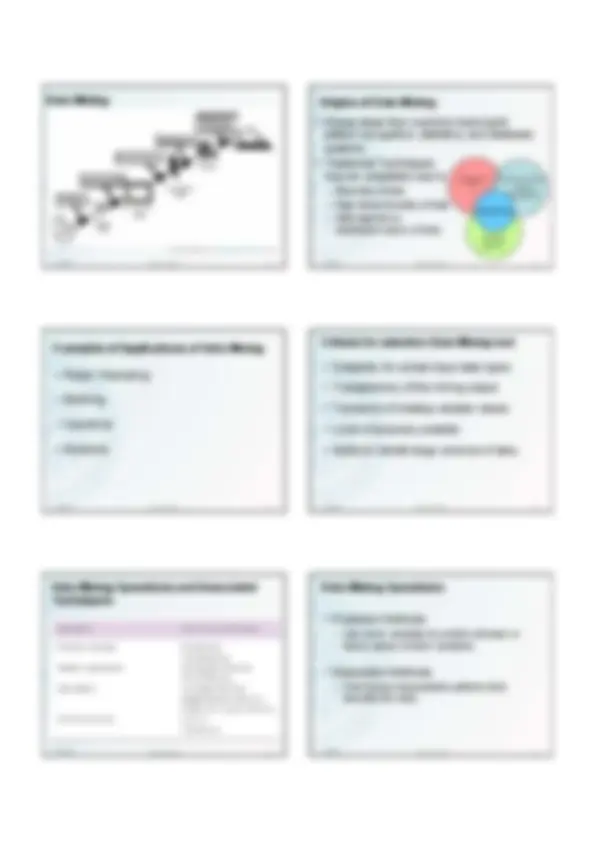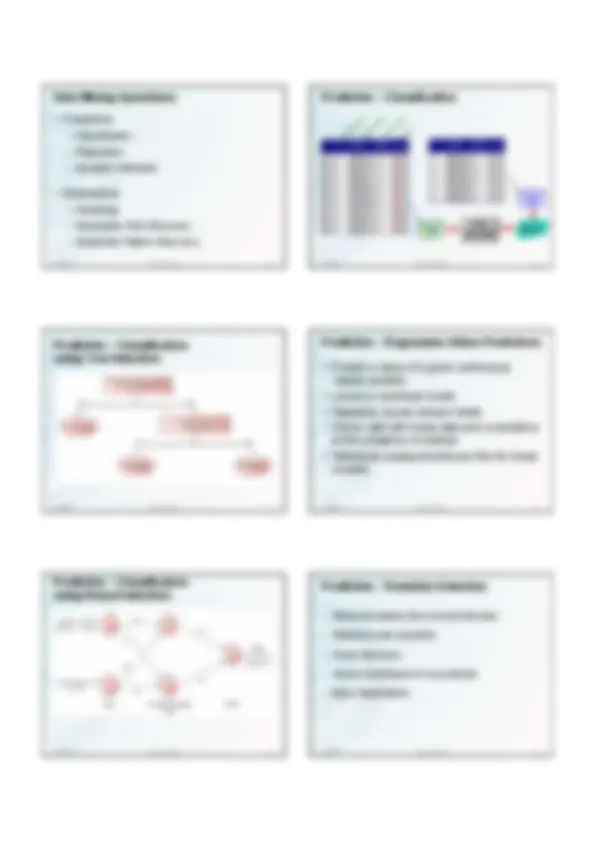Download DataBase Development and Implementation Lec19 - OLAP and Data Mining and more Study notes Database Management Systems (DBMS) in PDF only on Docsity!
DBDI/ Lecture 19
OLAP & Data Mining
Dr. Ala Al-Zobaidie
The slides are based on the textbooks:Database Systems by Thomas Connolly & Carolyn Begg (4th (^) ed.), Introduction to Data Mining, by Pang-Ning Tan, et.al., 2006 30/05/2007 DBDI / OLAP & DM 2
Objectives
- The relationship between OLAP and DW.
- Key features of OLAP applications.
- 12 rules for OLAP tools.
- Main categories of OLAP tools.
- OLAP extensions to the SQL standard
30/05/2007 DBDI / OLAP & DM 3
Business Intelligence Technologies
- Need of access tools to perform advanced analytical capabilities.
- two main types:
- Online Analytical Processing (OLAP)
- Data Mining (DM)
- An environment that includes a DW with tools (e.g. OLAP, DM) Î Business Intelligence (BI) technologies
30/05/2007 DBDI / OLAP & DM 4
OLAP Benchmarks
- Measuring OLAP performance for common business operations.
- Just-in-time (JIT) information for effective decision-making.
- Benchmark metric called AQM (Analytical Queries per Minute).
- Results include both the DB schema & required code.
- Data model flexibility.
Examples of OLAP applications in various functional areas
OLAP Applications key features
- Multi-dimensional views of data
- realistic’ business model
- access to corporate data
- treat all dimensions equally
- Support for complex calculations
- Mechanisms support powerful declarative computational methods
- Time intelligence
- Judging over time hierarchy
- Date and Period comparisons
30/05/2007 DBDI / OLAP & DM 7
OLAP Benefits
- Increased productivity of end-users.
- Reduced backlog of applications development for IT staff.
- Retention of organizational control over the integrity of corporate data.
- Reduced query drag and network traffic on OLTP systems or on the data warehouse.
- Improved potential revenue and profitability.
30/05/2007 DBDI / OLAP & DM 8
Multi-dimensional Data as Three-field table versus Two-dimensional Matrix
30/05/2007 DBDI / OLAP & DM 9
Multi-dimensional Data as 4-field Table versus 3-dimensional Cube
Region Month
Product 30/05/2007 DBDI / OLAP & DM 10
OLAP Tools & Codd’s Rules for OLAP Systems
- Available OLAP tools in marketplace.
- Codd’s Rules:
- Multi-dimensional conceptual view
- Transparency
- Accessibility
- Consistent reporting performance
- Client-server architecture
- Generic dimensionality
- Dynamic sparse matrix handling
- Multi-user support
- Unrestricted cross-dimensional operations 10.Intuitive data manipulation 11.Flexible reporting 12.Unlimited dimensions and aggregation levels
Categories of OLAP Tools
- OLAP tools are categorized according to the architecture used to store and process multi-dimensional data.
- There are four main categories:
- Multi-dimensional OLAP (MOLAP)
- Relational OLAP (ROLAP)
- Hybrid OLAP (HOLAP)
- Desktop OLAP (DOLAP)
Multi-dimensional OLAP & Typical Archit’ure
- Specialized data structures & MDDBMSs.
- Aggregated Data
- Array technology & efficient storage techniques.
- Excellent performance.
- Tight coupling.
- Use APIs.
- Development Issues
- Limited representation ability
- Limited Navigation and analysis ability
- Required high skills & advanced tools
30/05/2007 DBDI / OLAP & DM 19
Data Mining
From [Pang-Ning Tan , et.al.] Introduction to Data Mining , 2006 30/05/2007 DBDI / OLAP & DM 20
- Draws ideas from machine learning/AI, pattern recognition, statistics, and database systems
- Traditional Techniques may be unsuitable due to - Enormity of data - High dimensionality of data - Heterogeneous, distributed nature of data
Origins of Data Mining
Machine Learning/ Pattern Recognition
Statistics/ AI
Data Mining
Database systems
30/05/2007 DBDI / OLAP & DM 21
Examples of Applications of Data Mining
- Retail / Marketing
- Banking
- Insurance
- Medicine
30/05/2007 DBDI / OLAP & DM 22
Criteria for selection Data Mining tool
- Suitability for certain input data types
- Transparency of the mining output
- Tolerance of missing variable values
- Level of accuracy possible
- Ability to handle large volumes of data.
Data Mining Operations and Associated Techniques
Data Mining Operations
- Prediction Methods
- Use some variables to predict unknown or future values of other variables.
- Description Methods
- Find human-interpretable patterns that describe the data.
30/05/2007 DBDI / OLAP & DM 25
Data Mining Operations
- Predictive
- Classification
- Regression
- Deviation Detection
- Descriptive
- Clustering
- Association Rule Discovery
- Sequential Pattern Discovery
30/05/2007 DBDI / OLAP & DM 26
Predictive / Classification
Tid Refund MaritalStatus TaxableIncome Cheat 1 Yes Single 125K No 2 No Married 100K No 3 No Single 70K No 4 Yes Married 120K No 5 No Divorced 95K Yes 6 No Married 60K No 7 Yes Divorced 220K No 8 No Single 85K Yes 9 No Married 75K No 1010 No^ Single^ 90K^ Yes
categoricalcategoricalcontinuousclass Refund Marital Status TaxableIncome Cheat No Single 75K? Yes Married 50K? No Married 150K? Yes Divorced 90K? No Single 40K? 10 No^ Married^ 80K^?^ TestSet
TrainingSet Learn Model Classifier
30/05/2007 DBDI / OLAP & DM 27
Predictive / Classification using Tree Induction
30/05/2007 DBDI / OLAP & DM 28
Predictive / Regression (Value Prediction)
- Predict a value of a given continuous valued variable
- Linear or nonlinear model
- Statistics, neural network fields
- Works well with linear data and is sensitive to the presence of outliers
- Statistical measurements are fine for linear models
Predictive / Classification using Neural Induction
Predictive / Deviation Detection
- Detect deviations from normal behavior
- Relatively new operation
- A true discovery
- Various techniques & by-products
- Many Applications
30/05/2007 DBDI / OLAP & DM 37
Summary
- Relationship between OLAP and DW.
- Key features of OLAP applications.
- 12 rules for OLAP tools.
- Main categories of OLAP tools.
- OLAP SQL extension
- Data mining concept and process.
- Techniques associated with the data mining operations.
- Characteristics of data mining tools.
- The relationship between data mining and data warehousing.
- Challenges in Data Mining














